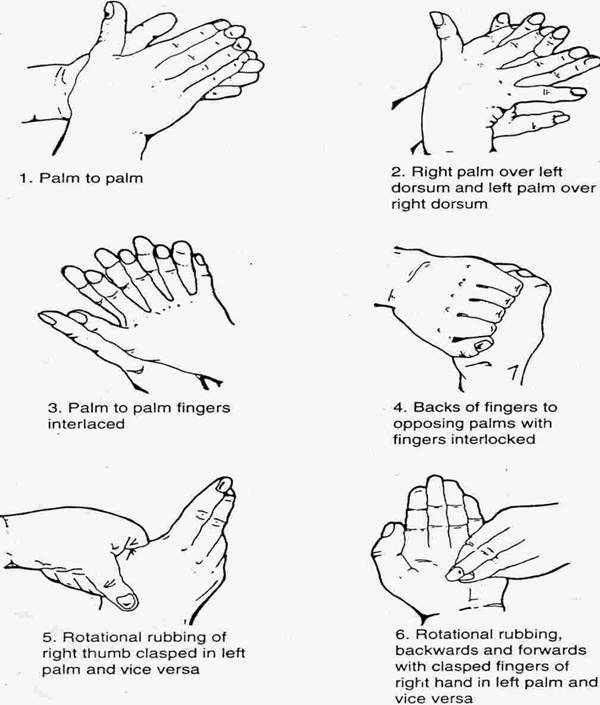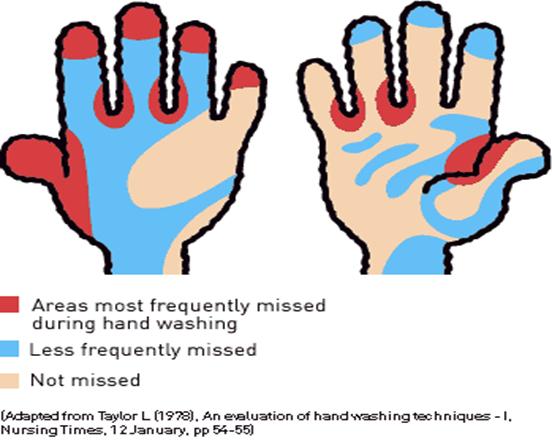What! Will these hands ne’er be clean? William Shakespeare (Macbeth)
5 moments of hand hygeine
The link between hand washing and contact transmission of infection was first established by Oliver Wendell Holmes in the US (1843) and in Europe by Semmelweiss (1861) (Horton, 2002). It was again well supported by Larson (1981). They both showed a drop in the rate of puerperal sepsis and its associated mortality when medical staff washed their hands between examining women during childbirth. Hands are the principle route by which cross infection occurs (Elliot, 1992). The Strategy for the Control of Antimicrobial Resistance in Ireland (SARI) was launched in 2001 and is available in the Mercy University Hospital Library and the Health Protection Surveillance Centre (01) 876 5300.
5 moments
What Are Your Hands Carrying?
Micro-organisms found on the skin include two categories:
(A) Resident Micro-Organisms (normal flora)
These are usually deep seated in the epidermis, are not readily removed and do not readily cause infections. However, during surgery/invasive procedures, they may enter deep tissues and establish an infection.
(B) Transient Micro-Organisms
These are organisms that are not part of the normal flora and represent recent contamination, that usually survives for a limited period of time. They are easily removed by a good hand washing technique. They include most of the organisms responsible for cross infection, e.g. Gram-negative bacilli (E.coli, Klebsiella, Pseudomonas spp, Salmonella spp.), Staph aureus, MRSA and viruses e.g. rotaviruses (Damani, N.N. (1997)).
Different Levels of Hand Hygiene
There are three recommended levels of Hand Hygiene to ensure that the hand hygiene performed is suitable for the task being undertaken. The efficacy of hand hygiene will depend on application of an adequate volume of a suitable hand hygiene agent with good technique for the correct duration of time, and finally ensuring that hands are dried properly.
(A) Social Hand Hygiene- Routine Hand Washing
The aim of social (routine) hand washing with soap and warm water is to remove dirt and organic material, dead skin and most transient organisms. On visibly clean hands it can be undertaken using an alcohol hand rub, and this will remove transient organisms.
(B) Antiseptic Hand Hygiene
Antiseptic hand disinfection with an antiseptic hand wash agent i.e. Hydrex is generally carried out for aseptic procedures on the ward and for areas of Isolation. Hygienic hand disinfection will remove and kill most transient micro- organisms- indications for use
- During outbreaks of infection where contact with blood/body fluids or situations where microbial contamination is likely to occur
- In “high” risk areas e.g. isolation, ICU etc
- Before/after performing an invasive procedure
- Before/after wound care, urethral or IV catheters etc
(C) Surgical Hand Hygiene
Surgical hand washing requires the removal and killing of transient micro-organisms and substantial reduction and suppuration of the resident flora of the surgical team for the duration of the operation, in case a surgical glove is punctured/torn. Ensure that fingernails are kept short and clean. Wrist watches and jewellery MUST be removed before surgical hand disinfection (Bernthal E, 1997).
How to Wash Your Hands - Correct Technique
Hand washing with a good technique covering all surfaces of the hands at the right time is more important than the agent used or the length of time of hand washing. Do not use nail-brushes on the wards. Nail-brushes (soft, sterile) used only for Surgical Scrub.
(A) Preparation Check List
- Keep nails short - most bacteria on the hands come from beneath the nails
- Do not wear nail varnish or false nails
- Do not wear ridged/stoned rings
- Remove wrist watches and roll up or remove long sleeved clothing
(B) Sequence of events
- Wet hands under running water
- Dispense soap/antiseptic (5mls approx) into a cupped hand
- Hand wash for 10-15 seconds vigorously and thoroughly without adding more water
- Rinse hands thoroughly under running water
- Dry hands properly with a disposable towel. Drying is equally as important as washing – bacteria thrive in moisture
(C) Six step hand washing technique
- Each step consists of five strokes forward and five backward

(D) Areas most, less, not missed when hand washing

E) Alcohol Hand Rub Technique
- Follow the six steps already described except instead of using water dispense 3mls of the gel into the palm of the hand. Remember to rub the wrists of both hands
Alcohol Gels
These are alternative methods of hand disinfection as already described (section 4.5) They do not cleanse and, therefore it is important that hands should first be cleaned with soap and water, in the presence of visible contamination. They are particularly useful in areas where a wash hand basin is not readily available, or when return to a wash hand basin is impractical e.g. during a ward round, in between bed making ,during a dressing procedure or if the previously washed hands touch the curtain trolley etc. They are also particularly useful outside the door of an isolation room/area and for individual patient bed space in “high” risk areas and during outbreaks on the advice of infection control.
(F) Prometics XL Cream
- The use of Prometics XL Cream available from the Pharmacy Department (project of the Microbiology Laboratory) is also encouraged in the hospital. This cream can be used for the same purposes as alcohol rub and as it contains natural emollients which help to moisturise the skin staff are encouraged to use it 3-4 times daily
- The main active ingredient is a natural fatty acid present in small amounts in the skin. This is particularly active against VRE and MRSA and a protective shield against the organisms remains in the skin when Prometics is used unlike alcohol based products where the protective effect evaporates within seconds
- NB: Only a very minute amount is required to be efficient. Surplus may cause the hands to become greasy
(G) Surgical Hand Disinfection
Surgical Hand antisepsis should be performed prior to all surgical procedures. It involves thorough washing and disinfection of hands, subungual areas and forearms. The agent used must have broad spectrum microbial activity, act rapidly and persist on the skin over several hours Betadine is the agent used in the MUH- See Theatre Policies for full guidelines – available in the theatre and on the H Drive of the hospital network.
Skin Care- Look After Your Hands
Bacterial counts increase when skin is damaged
- Maintain an intact skin in as far as possible
- Always wet hands before applying soap or medicated agents
- Always rinse and dry hands thoroughly- drying is particularly important during the winter months when the hands have a tendency to become chapped
- Do not use communal pots of hand cream
- Always cover cuts and abrasions with an impermeable waterproof plaster
- Always wear disposable gloves when handling blood/body substances
Practical Points
- Only Liquid soap from a dispenser (disposable cartridge)
- Bar soap is only allowed for patients own personal use
- Never use open topped jars of hand emollients
- Gloves - should never be regarded as a substitute for hand washing
- Never discard disposable towels in the toilet bowl, bed pan washer or macerator
- No need to use several sheets of disposable paper